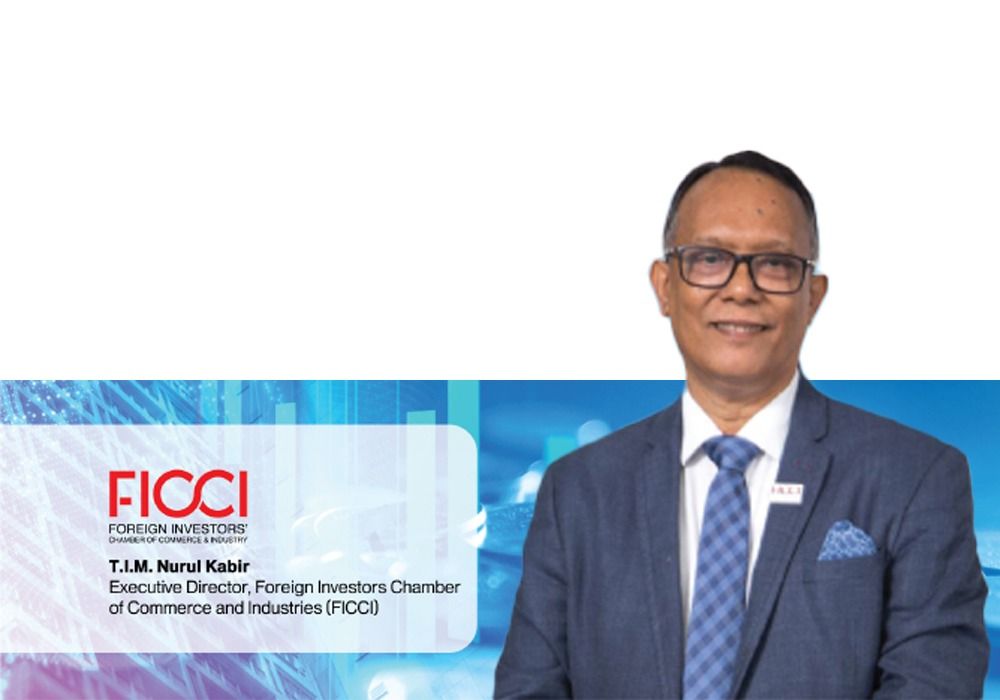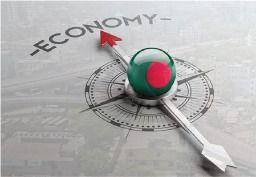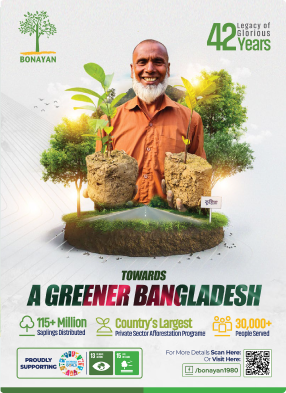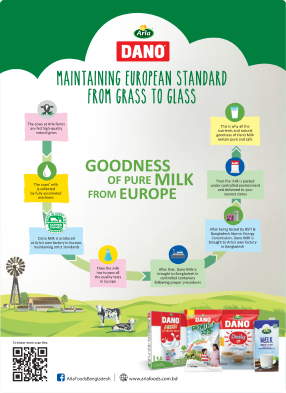- info@ficci.org.bd
- |
- +880248814801, +880248814802
- Contact Us
- |
- Become a Member
- |
- |
- |
- |
- |

Economic resilience amidst challenges
Despite multiple challenges, including natural disasters and political uncertainty form time to time, Bangladesh has immense prospects of trade growth and investment. With a track record of resilient economic performance amidst challenges, Bangladesh has come a long way, from being one of the poorest nations in the world dependent on humanitarian aid, to one of the fastest growing economies in the region.
 Export-led growth spearheaded by the Readymade Garments (RMG) industry has been the major driving force behind economic development and social progress achieved by Bangladesh. Merchandise exports in Bangladesh grew from $6.5 billion in 2003 to $55.0 billion in 2023, of which apparel exports accounted for $5 billion in 2003 and $47 billion in 2023.
Export-led growth spearheaded by the Readymade Garments (RMG) industry has been the major driving force behind economic development and social progress achieved by Bangladesh. Merchandise exports in Bangladesh grew from $6.5 billion in 2003 to $55.0 billion in 2023, of which apparel exports accounted for $5 billion in 2003 and $47 billion in 2023.
As Bangladesh is scheduled to graduate from Least Developed Country (LDC) status to a Developing Economy in November 2026, a new set of post-LDC challenges need to be addressed to reinvigorate business-friendly environment favorable for expansion of trade and investment.
 Supply Chain realignment
Supply Chain realignment
Affected by recent disruptions to global value chains such as the COVID-19 pandemic, the war in Ukraine, protectionist policies and rising ideological tensions global trade has recently registered downturn. According to the UNCTAD Handbook of Statistics 2024, developed economies registered decreasing exports of 2.8 per cent in 2023. In developing economies overall decrease was starker at 6.2 percent.
 Current geopolitics is realigning supply chains and reshaping the global economy. As policymakers in developed and developing economies are more focused on building economic resilience, homegrown economics, strategic autonomy and supply chain realignment are getting precedence. By diversifying export and engaging in bilateral and multilateral negotiations policymakers and stakeholders in Bangladesh have the opportunity to transform the challenges arising from shifting global trade pattern into opportunity at hand.
Current geopolitics is realigning supply chains and reshaping the global economy. As policymakers in developed and developing economies are more focused on building economic resilience, homegrown economics, strategic autonomy and supply chain realignment are getting precedence. By diversifying export and engaging in bilateral and multilateral negotiations policymakers and stakeholders in Bangladesh have the opportunity to transform the challenges arising from shifting global trade pattern into opportunity at hand.
Challenges and Competitiveness
 Bangladesh is scheduled to graduate from LCD status in 2026. This graduation from LDC to a Developing Economy is an official recognition of how far Bangladesh has progressed in its economic development and in achieving social development goals. However, LDC graduation will have a major impact on the exports of Bangladesh.
Bangladesh is scheduled to graduate from LCD status in 2026. This graduation from LDC to a Developing Economy is an official recognition of how far Bangladesh has progressed in its economic development and in achieving social development goals. However, LDC graduation will have a major impact on the exports of Bangladesh.
Since gaining the LDC status in 1975, Bangladesh has enjoyed zero-duty benefits on exports to different destinations including developed and developing nations. As a result, Bangladesh has been performing strongly in merchandise exports, especially in the shipment of readymade garments.
The export-oriented RMG industry grew in Bangladesh owing to a unique Multi-Fiber Arrangement (MFA) quota system that restricted trade in textiles and clothing in developed countries by limiting exports from countries that could have otherwise achieved higher export volumes. Implementation of MFA opened export opportunities for Bangladesh as MFA offered guaranteed market and provided opportunity to develop and acquire necessary production and marketing skills.
After quotas were abolished in 2005, prevalence of Most Favored Nation (MFN) tariffs and trade policy instrument such as Generalized System of Preferences (GSP) and Free Trade Agreement (FTA) favored the growth of the RMG industry in Bangladesh. Bangladesh, as an LDC, enjoys unilateral trade preferences in Canada, the UK, and the EU.
After graduation from LCD status exporters in Bangladesh are likely to face 11.5 percent duty in major export destinations in the EU. Duty is likely to be imposed in other emerging markets also. For example, duties would be levied at 20 percent in India and 18 percent in Japan. This underscores the urgency of securing Free Trade Agreements (FTAs) and Comprehensive Economic Partnership Agreements (CEPAs) with key trading partners, including Japan, Singapore, India, Malaysia, and other non-traditional trading partners.

The EU and some countries such as Canada, Australia and the UK have already agreed to grant a three-year grace period to graduating LDCs. This means Bangladesh would be able to avail duty-free access up to 2029. Moreover it has been decided at the 13th WTO Ministerial Conference in Abu Dhabi 2024 that graduating LDCs would be given the facilities for three more years, in which case, graduating countries will have to negotiate with their trading partners. This implies that Bangladesh will have to sign trade pacts with partner countries in order to retain preferential market access.
In case of the US, apparel exporters in Bangladesh have always had to face a 15.62 percent duty on export. Despite 15.62 percent export duty, Bangladesh has been able to outperform competitor countries in January 2025 in attaining the highest year-on-year growth in apparel shipments to the US market. According to data from the US Office of Textiles and Apparel (OTEXA), garment exports to the US from Bangladesh increased by 45.93 percent year-on-year to $799.65 million; whereas apparel exports of China to the US rose by 13.72 percent to $1.60 billion; that of Vietnam, 19.90 percent to $1.44 billion, and India 33.64 percent to $473.27 million. This outstanding achievement signifies the importance of competitiveness for trade growth and investment.

The urgency of competitiveness and export diversification is further heightened by the upcoming LDC graduation in 2026. While exporters should make the most of this continued trade benefit for LDCs, the government of Bangladesh should make collaborative negotiations with major partners to sign FTA, Economic Partnership Agreement (EPA), and Preferential Trade Agreement (PTA).
Bangladesh immediately needs to engage in active economic diplomacy to maximize national gain in trade and investment and to prioritize the Economic Partnership Agreement (EPA) with neighboring, regional, and international trade partners, including India, China, Russia, Korea, Japan, the US, and others.
 Economic diplomacy is not only the engagement of professional diplomats and government officials. In a transforming global trade landscape, economic diplomacy is a coordinated collaboration among all economic stakeholders, including investors, non-government organizations (NGOs), industry experts, and private sector representatives.
Economic diplomacy is not only the engagement of professional diplomats and government officials. In a transforming global trade landscape, economic diplomacy is a coordinated collaboration among all economic stakeholders, including investors, non-government organizations (NGOs), industry experts, and private sector representatives.
To expand trade and investment and enhance competitiveness, stakeholder perspectives on multiple issues need to be pooled, which include, among others, cross-border trade, supply chain, infrastructure and logistic support, connectivity, customs and regulations, climate change impact, technology, 4IR, and upskilling.





